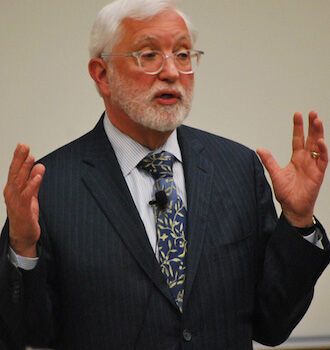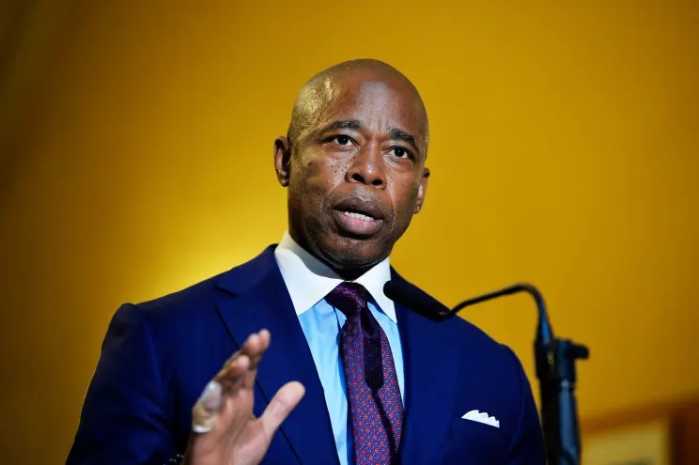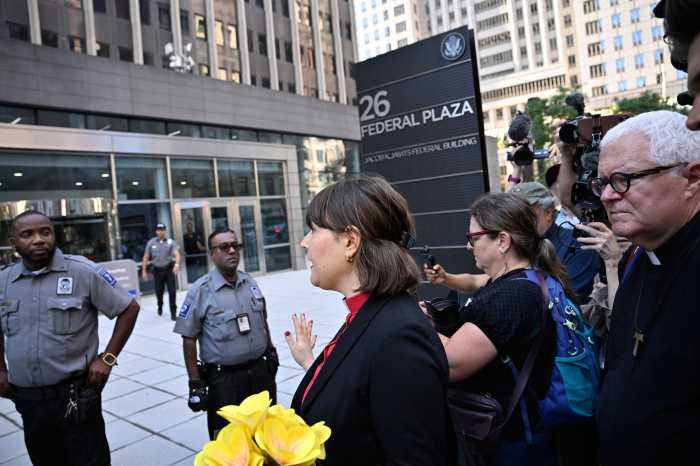BY ARTHUR S. LEONARD | For the first time within the US Second Circuit, a district court judge has ruled that a transgender person’s equal protection claim will receive “heightened scrutiny.” The November 15 ruling by Senior Judge Jed Rakoff of the Southern District of New York, in Adkins v. City of New York, relied on the Second Circuit’s decision in Windsor v. United States, which found that anti-gay discrimination merited a heightened scrutiny review. (That ruling was affirmed by the Supreme Court on alternative due process grounds.)
Heightened scrutiny is the standard used to evaluate sex discrimination claims, and it places the burden on the government to show that the discriminatory treatment significantly advances an important government interest. In this case, the city is defending steps that police officers took in detaining a transgender man arrested during the 2011 Occupy Wall Street Brooklyn Bridge demonstration.
Rakoff’s ruling should be a wake-up call to the New York City Police Department, since it rests in part on Justin Adkins’ allegations that the department follows a policy of discrimination against transgender detainees and has failed to take any action in response to internal recommendations to modify its policies.
Southern District Judge Jed Rakoff’s finding first within Second Circuit’s jurisdiction
Adkins was arrested on the Brooklyn Bridge on October 1, 2011 and taken to the 90th precinct and placed in a cell with other men. Although neither Adkins nor anyone else in the cell raised any complaint about his presence, after police officers identified him as transgender, they removed him, seating him in a chair next to the bathroom handcuffed to a metal rail along the wall, where he was left for seven hours. Other detainees were fed, but he was not. He alleges that being restrained in that awkward position for so long caused soreness in his arm and shoulder that lasted for several weeks. He was ultimately released without being prosecuted.
Adkins leveled a barrage of constitutional claims against the police officers responsible for this treatment and against the city as their employer. The city moved to dismiss his lawsuit, and Rakoff dismissed most of the claims in summary fashion, but he found that the equal protection claim had enough merit to survive.
An equal protection claim must allege that the plaintiff was “treated differently than others similarly situated as a result of intentional or purposeful discrimination” and that “the disparity in treatment cannot survive the appropriate level of scrutiny.”
Rakoff found that Adkins had adequately alleged differential treatment, and that this treatment was purposeful “because it was pursuant to the NYPD’s custom of subjecting transgender detainees to special conditions,” such as, in this case, “handcuffing them to railings.”
Adkins also alleged discriminatory intent, citing individual police officers’ “responses to learning of his transgender status, which included gawking, giggling, and inquiring about his genitalia.” Rakoff found that this met the plausibility requirements for pleading a constitutional claim.
The main issue, then, in deciding whether to dismiss the claim was whether Adkin’s complaint merits “heightened scrutiny” or would be relegated to the “rational basis” standard of review, a deferential standard under which the officers and the city would escape liability if there was any imaginable justification for their action.
Rakoff turned to the Second Circuit’s Windsor decision, which analyzed this question in the context of the Defense of Marriage Act, which required the federal government to withhold any recognition of same-sex marriages performed under state law. There, the appeals court held that heightened scrutiny would apply, finding that gay people qualify as a “quasi-suspect class.”
Rakoff reached a similar conclusion regarding transgender people, applying the same sort of reasoning.
“While transgender people and gay people are not identical,” he wrote, “they are similarly situated with respect to each of Windsor’s four factors.”
The first factor is deciding whether there is a history of persecution and discrimination based on membership in the class. The Second Circuit said that this factor is “not much in debate” for gay people. Speaking of transgender people, Rakoff wrote that “this history of persecution and discrimination is not yet history. Plaintiff cites data indicating that transgender people report high rates of discrimination in education, employment, housing, and access to healthcare.”
The second factor is deciding whether the status in question bears any relation to the ability of class members to contribute to society. “Some transgender people experience debilitating dysphoria while living as the gender they were assigned at birth,” he wrote, “but this is the product of a long history of persecution forcing transgender people to live as those who they are not. The Court is not aware of any data or argument suggesting that a transgender person, simply by virtue of transgender status, is any less productive than any other member of society.”
The third factor is deciding whether transgender status “is a sufficiently discernible characteristic to define a discrete minority class,” and Rakoff found that it is. Here the Windsor analysis really came in handy.
“Windsor helpfully describes the scenarios of a person of illegitimate birth applying for Social Security benefits and thereby making their illegitimate status manifest, or two gay people seeking a marriage license and thereby revealing their homosexuality,” he wrote. “Transgender people struggle with similar scenarios on an even more frequent basis: many forms of identification required for asserting legal rights, such as birth certificates, indicate the bearer’s gender. A mismatch between the gender indicated on the document and the gender of the holder calls down discrimination, among other problems. Document troubles aside, transgender people often face backlash in everyday life when their status is discovered. For instance, plaintiff alleges that, upon learning that he was transgender, police officers gawked and giggled at him and asked him what he had ‘down there.’”
Finally, courts look at whether a particular class is a “politically powerless minority,” and here, too, Rakoff found transgender status met the criteria.
“Particularly in comparison to gay people at the time of Windsor, transgender people lack the political strength to protect themselves,” he wrote, citing as an example the continued exclusion from military service. “Moreover, like gay people, it is difficult to assess the degree of underrepresentation of transgender people in positions of authority without knowing their number relative to the cisgender population. However, in at least one way this underrepresentation inquiry is easier with respect to transgender people: for, although there are and were gay members of the United States Congress (since Windsor, in both houses), as well as gay federal judges, there is no indication that there have ever been any transgender members of the United States Congress or the federal judiciary.”
Having found that heightened scrutiny applies, Rakoff concluded that Adkins had put into play the question whether his removal from a general cell and handcuffing to a rail for seven hours was “substantially related to an important government interest.”
The city’s response was to argue that “there is no constitutional right to be detained with cellmates of the same gender,” but there they cited a case that did not involve heightened scrutiny, and so it didn’t address the question.
The city also invoked “safety concerns,” referring to Adkins’ own complaint, which alleged that “numerous transgender individuals detained by the NYPD have alleged that they have been placed with individuals who posed a risk to their safety.” But Rakoff pointed out that Adkins had not alleged there were any safety concerns here: “Neither he nor the men with whom he was initially held raised any safety concerns.”
Rakoff added, “Moreover, defendants cannot argue their actions were substantially related to ensuring plaintiff’s safety when they removed him from an allegedly safe place and caused him injury, albeit minimal injury, by handcuffing him to a wall next to the sole bathroom in the precinct.”
However, since Rakoff’s ruling was the first in the Second Circuit to conclude that heightened scrutiny applied to transgender equal protection claims, it could not come into play against the individual police officer defendants in the case. Under the “qualified immunity” doctrine, individual public officials can be held liable for constitutional violations only when they violate established rights, not rights newly-identified in the case in which they are being sued. Even if one dates the heightened scrutiny analysis back to the Second Circuit’s Windsor decision, it was announced more than a year after Adkins was arrested.
“Accordingly, defendants could not be expected to know that their actions could be subject to any standard more stringent than rational basis review,” Rakoff wrote.
Although Rakoff refrained from deciding whether Adkin’s complaint would survive a motion to dismiss using rational basis review, he concluded that it would have been “objectively reasonable for defendant [officers] to conclude” that it would not, so “qualified immunity” applies in their cases.
The qualified immunity doctrine, however, does not protect the city as a defendant, Rakoff found. In order to hold the city liable, Adkins would have to plausibly allege a practice or policy of discriminatory treatment of transgender detainees.
“Plaintiff has alleged that both eyewitness accounts and internal police documents show the existence of a specific pattern of misconduct, viz., handcuffing transgender detainees to railings, and further show official inaction in the face of this pattern,” he wrote. “Plaintiff claims that an internal NYPD recommendation called for changes in the department’s treatment of transgender people, but the NYPD chain of command took no steps in response to it. He claims that numerous transgender people detained by the NYPD have alleged they were chained to railings,” citing, among other things, a 2007 deposition by a transgender man who had been subject to such treatment.
Rakoff ruled that Adkins’ allegations were sufficient to survive the city’s motion to dismiss his claim, finding that he had “nudged his claims across the line from conceivable to plausible.
Adkins’ claim against the city for violating his rights under the 14th Amendment’s Equal Protection Clause, therefore, may go to trial if the city does not offer an acceptable settlement. Rakoff instructed the attorneys to jointly call his chambers by “no later than November 19 to schedule further proceedings with regard to the remaining claim.”
Adkins’ attorneys cited the Atlanta-based 11th Circuit Court of Appeals’ decision in Glenn v. Brumby in support of their heightened scrutiny claim. In that case, the court found that a transgender woman could maintain a constitutional claim against a state legislative office where she was employed alleging an equal protection violation based on her gender identity.
Andrea Juanita Ritchie, a Brooklyn attorney, represents Adkins. The City Law Department attorneys working on the case are Dara Lynn Weiss and Cheryl Leah Shammas.



































